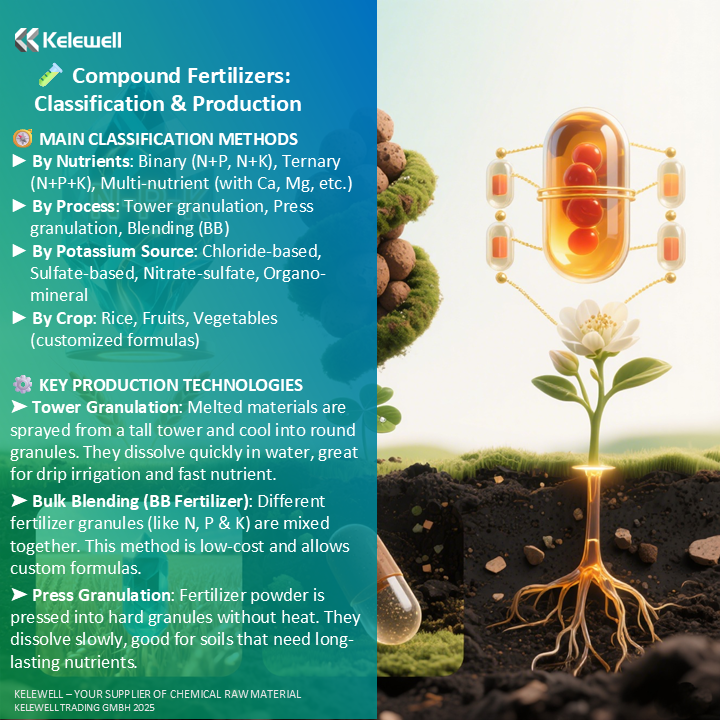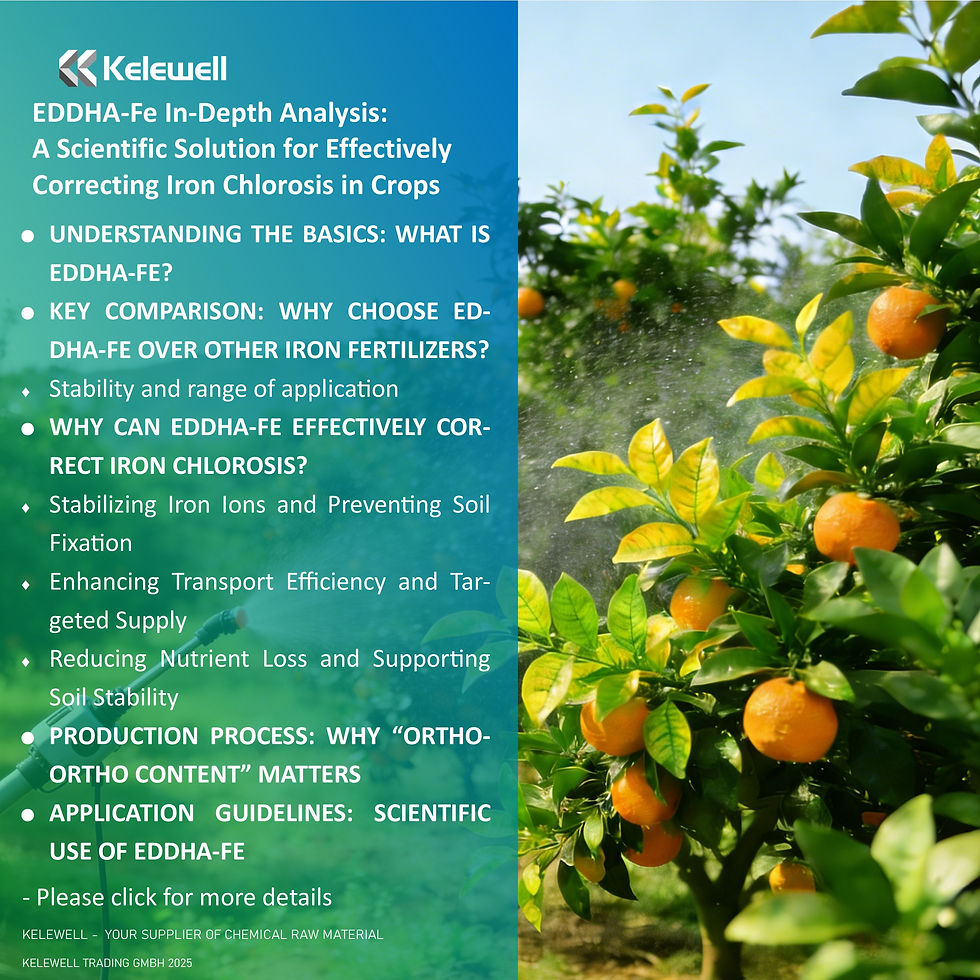Understanding Compound Fertilizers: Types, Manufacturing Methods, and Application Guidance
- Camille W.

- Jul 30
- 4 min read
Fertilizers come in many types and can be classified into various categories:
By chemical composition: Organic fertilizers, inorganic fertilizers, and organo-mineral fertilizers
By nutrient content: Straight fertilizers, compound/blended fertilizers (multi-nutrient)
By nutrient release speed: Fast-release fertilizers, slow/controlled-release fertilizers
By physical state: Solid fertilizers, liquid fertilizers, gaseous fertilizers
By chemical properties: Alkaline fertilizers, acidic fertilizers, neutral fertilizers
Among these, compound or blended fertilizers (multi-nutrient fertilizers) have been extensively introduced in our previous post, including their definitions, usage, advantages, and disadvantages. For a detailed review, please refer to the following link:🔗 https://www.kelewell.de/en/post/blended-fertilizer-compound-fertilizer-and-complex-fertilizer-understanding-the-differences
What is Compound Fertilizer?
Compound fertilizer refers to fertilizers containing two or more of the three essential nutrients: nitrogen (N), phosphorus (P), and potassium (K). These fertilizers offer high nutrient content, fewer secondary components, and favorable physical properties. They play a critical role in balanced fertilization, enhancing fertilizer use efficiency, and supporting stable and high crop yields.
As a major fertilizer category, compound fertilizers can be further subdivided based on nutrient composition, production process, functional characteristics, and crop specificity.
I. Mainstream Classification Methods
(1) By Nutrient Composition1. Binary Compound Fertilizers
N-P Type (e.g., Monoammonium Phosphate): Suitable for phosphorus-deficient soils or crops in phosphorus-demanding stages (e.g., rapeseed, potatoes).
N-K Type (e.g., Potassium Nitrate): Ideal for leafy vegetables (e.g., spinach) or chlorine-sensitive crops (e.g., tobacco).
2. Ternary Compound Fertilizers
Balanced Type: Versatile use throughout the entire growth cycle of field crops like wheat and rice (e.g., 15-15-15).
High-N Type: Designed for vegetative growth in crops like maize and sugarcane (e.g., 30-5-5).
High-K Type: Recommended for tuber crops (e.g., sweet potatoes), fruiting vegetables (e.g., tomatoes), and fruit trees during fruit enlargement (e.g., 15-15-20).
3. Multi-Nutrient Compound Fertilizers
Fortified with secondary and micronutrients (e.g., calcium, magnesium). Best suited for cash crops like citrus and grapes or for improving poor soils.
(2) By Production Process1. Tower Granulation Process
Offers excellent water solubility (e.g., tower-based nitrate-sulfate compound fertilizers). Suitable for drip irrigation or crops requiring rapid nutrient uptake.
2. Press Granulation
Slow-release characteristics make it suitable for sandy soils or low-input systems (e.g., eucalyptus plantations).
3. Bulk Blending (BB Fertilizer)
Customizable formulas ideal for precision agriculture requiring flexible nutrient adjustments.
(3) By Potassium Source and Functional Properties1. Chloride-Based Compound Fertilizers
High-chlorine type (Cl >30%): Suitable only for chlorine-tolerant crops (e.g., rice, maize).
Low-chlorine type (Cl 3%-15%): Use cautiously for chlorine-sensitive crops (e.g., tobacco, strawberries).
2. Sulfate-Based Compound Fertilizers
Contain potassium sulfate; suitable for all cash crops (e.g., tea, watermelon), though more expensive.
3. Nitrate-Sulfate Compound Fertilizers
Include nitrate nitrogen for rapid efficacy. Recommended for solanaceous crops (e.g., tomatoes) or early-stage topdressing.
4. Organo-Mineral Compound Fertilizers
Include humic acid, improve saline-alkaline soils, and are ideal for organic farming or land with continuous cropping barriers.
(4) By Crop-Specific ApplicationsRice Fertilizer: Emphasizes high nitrogen + moderate phosphorus and potassium (e.g., 25-13-7).
Fruit Tree Fertilizer: High potassium + trace elements (e.g., 15-5-25 + Zn).
Leafy Vegetable Fertilizer: High-nitrogen type (e.g., 20-10-10).
Chlorine-sensitive Crops (e.g., tobacco, grapes): Avoid chloride-based fertilizers; prioritize sulfate or nitrate-sulfate types. For mildly alkaline soils, acidic fertilizers such as MAP (monoammonium phosphate) are recommended. For cash crops, potassium humate-enhanced compound fertilizers are suggested to improve quality.
II. Mainstream Compound Fertilizer Production Processes
Compound fertilizer production can be broadly divided into three categories: chemical synthesis, physical mixing, and special granulation techniques. Each process affects the product's performance and application scenarios.
(1) Chemical Synthesis Methods1. Tower Granulation
Process: Urea/ammonium nitrate melt (135 °C) → mixed with phosphate and potash raw materials into slurry → sprayed from the top of a 45–125 m tower → cooled and solidified during free fall.
Features: Uniform granules; contains biuret (up to ~1.5%); best for high-nitrogen formulas (phosphorus ≤15%).
Example: Urea integration technology (e.g., twin-tower process using urea solution directly without crushing).
2. Ammoniation Granulation
Involves reacting ammonia gas with phosphoric acid to form ammonium phosphate, then mixing with other materials. Nitrogen content can exceed 14%, with ≥95% water-soluble phosphorus.
(2) Physical Mixing Methods1. Blending (BB Fertilizer)
Direct mixing of straight N, P, and K fertilizers. Requires matching granule sizes (e.g., urea 2–4 mm, KCl screened >16 mesh). The coefficient of variation in nutrient uniformity should be <5%.
Advantages: Formula flexibility (e.g., 20-15-10 corn fertilizer), equipment costs ~40% of tower systems.
2. Rotary Drum Granulation
Uses physical tumbling for agglomeration. Simpler process but often results in uneven nutrient distribution, lower solubility, and higher nutrient loss.
(3) Special Granulation Techniques1. Press Granulation
Dry process forming granules under pressure (10–50 MPa); suitable for low-moisture raw materials (10–15%). Produces hard but slow-dissolving granules.
2. Spray Granulation
Uses molten urea spray to form granules. Nitrogen content ~12%, water-soluble phosphorus ~80%. Mature technology but with lower nutrient use efficiency than ammoniation methods.
(4) Process Comparison and Application ScenariosProcess | Nutrient Uniformity | Typical Formulas | Recommended Applications |
Tower | High | 30-5-5 (High-N) | Topdressing, drip irrigation systems |
Blending | Moderate | Customizable | Precision agriculture, sandy soils |
Press | Low | Low-N, High-P&K | Slow-release needs, heavy clay soils |
💡 Smart Fertilization Tips:
Soil testing and balanced fertilization: Know your soil and crop needs; avoid blind application.
Combine organic and inorganic fertilizers: Sustain productivity while improving soil health.
Base fertilizer as primary, topdressing as support: Apply most P & K and part of N as basal; split-apply fast-acting N according to crop stages.
Targeted micronutrient supplementation: Based on soil tests and crop sensitivity.
Utilize biofertilizers: Particularly valuable for continuous cropping, degraded soils, and reducing chemical fertilizer use.
Adopt proper application methods:
Deep application and soil covering: Reduce ammonia volatilization
Concentrated application: Improve phosphorus use efficiency
Foliar spraying: Rapid absorption and stress mitigation




Comments